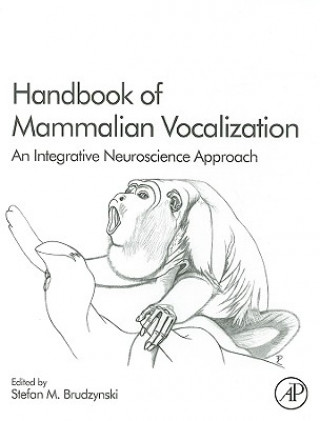
Kód: 04494214
Handbook of Mammalian Vocalization
The present proposal offers an outline of the planned major "Handbook on Mammalian Vocalization", which fills a clear niche existing in the science book literature and on the market. The handbook is designed as a broad and compreh ... celý popis
- Jazyk:
 Angličtina
Angličtina - Vazba: Pevná
- Počet stran: 546
Nakladatelství: Elsevier Books, 2009
- Více informací o knize

6070 Kč
Dostupnost:
50 % šance Máme informaci, že by titul mohl být dostupný. Na základě vaší objednávky se ho pokusíme do 6 týdnů zajistit.
Máme informaci, že by titul mohl být dostupný. Na základě vaší objednávky se ho pokusíme do 6 týdnů zajistit.Prohledáme celý svět
Mohlo by se vám také líbit
-

Pacific Crest Trail
463 Kč -

Juvenile Primates
5779 Kč -

Wylde
384 Kč -

Das Kindergesangbuch, 1 CD-Audio
381 Kč -

Glass Half-Empty, Glass Half-Full
2893 Kč -

On First Principles
616 Kč -

Monterey Bay Shoreline Guide
797 Kč -

Juvenile Primates
1608 Kč -

EU Energy Law and Policy
5234 Kč -

Seattle
466 Kč -

Monogamy
1187 Kč -

American Indian Fairy Tales
390 Kč -

You're the Boss
1239 Kč -

Applications of Fibonacci Numbers
2259 Kč
Dárkový poukaz: Radost zaručena
- Darujte poukaz v libovolné hodnotě a my se postaráme o zbytek.
- Poukaz se vztahuje na celou naši nabídku.
- Elektronický poukaz vytisknete z e-mailu a můžete ihned darovat.
- Platnost poukazu je 12 měsíců od data vystavení.
Informovat o naskladnění knihy
Zadejte do formuláře e-mailovou adresu a jakmile knihu naskladníme, zašleme vám o tom zprávu. Pohlídáme vše za vás.
Více informací o knize Handbook of Mammalian Vocalization
Nákupem získáte 607 bodů
 Anotace knihy
Anotace knihy
The present proposal offers an outline of the planned major "Handbook on Mammalian Vocalization", which fills a clear niche existing in the science book literature and on the market. The handbook is designed as a broad and comprehensive, but well-balanced book, written from the neuroscience point of view in the broad sense of this term. Only a few issues will be reduced, which are extensively covered in other recent book publications. The handbook is planned in a unique way and will not directly compete with other books on the market. This well-illustrated handbook will pay a particular attention to systematically organized details but also to the explanatory style of the text and internal cohesiveness of the content, so the successive chapters will gradually develop a consistent story without losing the inherent complexity. Studies from many species will be included, however, rodents will dominate, as most of the brain investigations were done on these species. The leading idea of the handbook is that vocalizations evolved as highly adaptive specific signals, which are selectively picked up by the brain. The brain serves as a receptor and behavioural amplifier. Brain systems will be described, which allow vocal signals rapidly changing the entire state of the organism and trigger vital biological responses, usually also with accompanying emission of vocalizations. Integrative brain functions leading to vocal outcome will be described, along with the vocalization generators and motor output to larynx and other supportive motor subsystems. The last sections of the handbook will explain bioacoustic structure of vocalizations, present understanding of information coding, and origins of the complex semiotic/semantic content of vocalizations in social mammals. The handbook is thought as a major source of information for professionals from many fields, with neuroscience approach as a common denominator. The handbook is planned to provide consistent and unified understanding of all major aspects of vocalization in a monographic manner, and at the same time, to give an encyclopaedic overview of major topics associated with vocalization from molecular/cellular level to behavior and cognitive processing. It is planned to be written in a strictly scientific way but clear enough to serve not only for specialized researchers in different fields of neuroscience but also for academic teachers of neuroscience, including behavioural neuroscience, affective neuroscience, clinical neuroscience, neuroethology, biopsychology, neurolingusitics, speech pathology, and other related fields, and also for research fellows, graduate and other advanced students, who widely need such a source publication. This is the first comprehensive handbook on what we know about vocalization in Mammalians. Currently the information on this topic is dispersed over journal articles and book chapters across a number of journals and books with different focus. The handbook will provide the researcher interested in animal and human communication, as well as the researcher interested in the control of motor systems by the brain finally with a comprehensive reference on the topic. The handbook will have great influence in providing for the first time a bridge from information on animal communication and its nervous system control to the neural control of language and language development in the human. Carefully edited, the handbook provides an integrated overview of the area. Instructors and students will find this handbook a useful background information in courses of animal and human communication, speech and language, the neuroethology of sound production and sound perception, and similar. This title is written by international list of highly regarded contributors, including Jaak Pankseep (Washington State University), David McFarland (Oxford), John D. Newman (NIH - Unit on Developmental Neuroethology), Gerd Poeggel (Leipzig), Shiba Keisuke (Chiba City, Japan), and others, tightly edited by a single, well regarded editor who has edited a special issue in "Behavioral Brain Research" on the topic before. Complete overview with contributions from the leading researchers from eleven countries in North America, Europe, Japan and Australia, presented in an integrated, tightly edited book.
 Parametry knihy
Parametry knihy
Zařazení knihy Knihy v angličtině Mathematics & science Biology, life sciences Life sciences: general issues
6070 Kč
- Plný název: Handbook of Mammalian Vocalization
- Podnázev: An Integrative Neuroscience Approach
- Jazyk:
 Angličtina
Angličtina - Vazba: Pevná
- Počet stran: 546
- EAN: 9780123745934
- ISBN: 0123745934
- ID: 04494214
- Nakladatelství: Elsevier Books
- Hmotnost: 1754 g
- Rozměry: 286 × 224 × 40 mm
- Datum vydání: 01. December 2009
Oblíbené z jiného soudku
-

The Molecule of More
399 Kč -

Evolution
675 Kč -

Power, Sex, Suicide
330 Kč -

Psychopath Inside
405 Kč -

Murderous Minds
384 Kč -

Science of Meditation
323 Kč -

Oxygen
303 Kč -

Race Differences in Intelligence
873 Kč -

Equine Genomics
5435 Kč -

The Selfish Gene
303 Kč -

Undoing Project
277 Kč -

Biology of Belief
442 Kč -

Power of Habit
239 Kč -

Sapiens
378 Kč -

Lifespan
597 Kč -

The Extended Phenotype
330 Kč -

Into the Magic Shop
368 Kč -

Homo Deus
323 Kč -

Cosmic Serpent
256 Kč -

Greatest Show on Earth
323 Kč -

Speculations on the Evolution of Human Intelligence
227 Kč -

Blind Watchmaker
378 Kč -

We Are Our Brains
323 Kč -

River Out of Eden
276 Kč -

Brain Book
544 Kč -

Human Brain Coloring Book
467 Kč -

Crack In Creation
366 Kč -

Schaum's Outline of Genetics, Fifth Edition
692 Kč -

Brain Rules (Updated and Expanded)
337 Kč -

Hidden History of the Human Race
346 Kč -

Fixing My Gaze
530 Kč -

Neanderthal Man
374 Kč -

Why We Run
407 Kč -

On Natural Selection
185 Kč -

Handbook of Spine Surgery
2450 Kč -

Cartoon Guide to Genetics
410 Kč -

Ecological Thought
808 Kč -

Creative Evolution
380 Kč -

Brief History of Everyone Who Ever Lived
213 Kč -

Consciousness
399 Kč -

Social Conquest of Earth
386 Kč -

Atlas of Human Brain Connections
4504 Kč -

Double Helix
452 Kč -

Masters of the Planet
392 Kč -

Vital Dust
823 Kč -

What Mad Pursuit
683 Kč -

Zooarchaeology and Modern Human Origins
2998 Kč -

Handbook of Schizophrenia Spectrum Disorders, Volume I
5094 Kč -

Tree of Life
1226 Kč
Osobní odběr Praha, Brno a 12903 dalších
Copyright ©2008-24 nejlevnejsi-knihy.cz Všechna práva vyhrazenaSoukromíCookies


 Vrácení do měsíce
Vrácení do měsíce 571 999 099 (8-15.30h)
571 999 099 (8-15.30h)